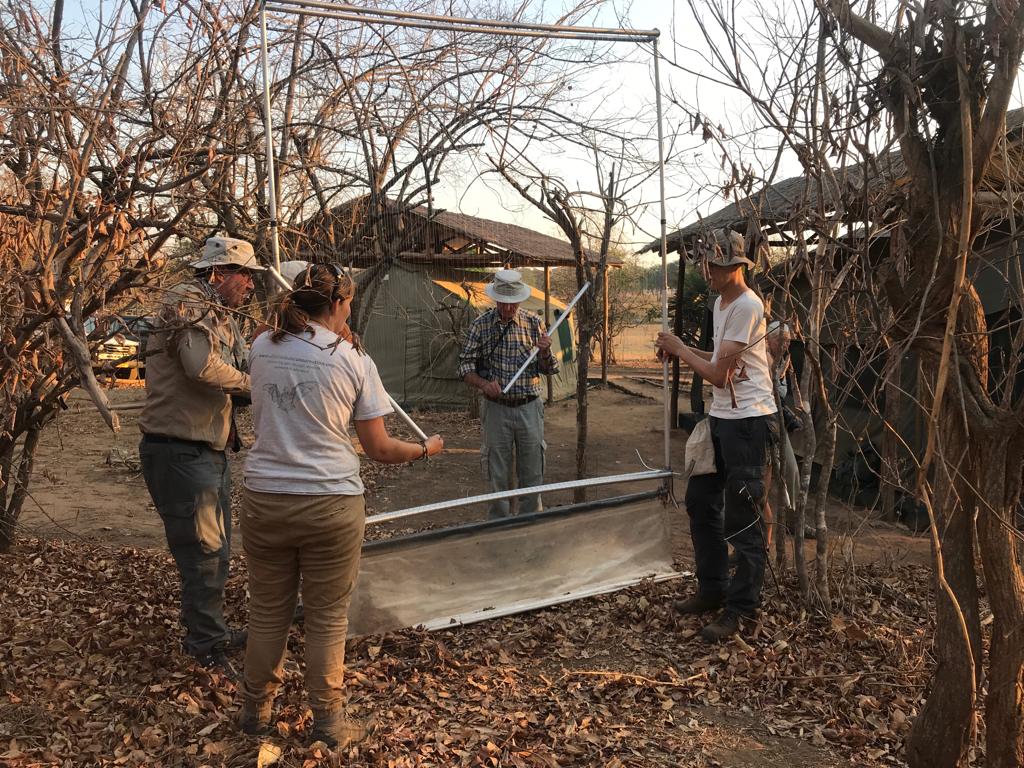Update from our Malawi expedition volunteering with elephants, hippo, cats, pangolins and African biodiversity
The team peacefully sitting in base camp checking camera trap images, studying ants under a microscope and sifting through fresh elephant dung were interrupted a moment ago by the VHF radio. LWT staff member Pili, leading the rest of the Biosphere team on a lakeside transect walk to count hippos, was calling for a rescue. The small group of our citizen scientists had been trapped by a herd of elephants on the floodplain. With good experience of elephant behaviour, Pili kept the team safe without problems, but they were blocked from walking back to camp by the elephants. At base camp, Benni and a couple of helpers jumped into a vehicle and set off to intercept and evacuate our trapped and intrepid citizen scientists. Not quite an everyday experience, but still, very much the kind of thing that can happen on an expedition that deserves its name.
The Malawi 2022 biodiversity expedition is in its last days, but there is no sign of it winding down. If anything, the team is operating at its best now: after initial training and many days of experience, the expedition is a well-oiled machine, with animal observations, sample collection & analysis, as well as data entry all being carried out with speed, efficiency and a smidgin of pride.
Each day starts with a dawn drive along the lakeside to look for elephants. Nobody has told the elephants this and so we have rarely spotted them at this time of day, but those of us happy to get up at 05:00 are rewarded with the sights and sounds of Malawian wildlife in the warm light of sunrise. All the team are up for breakfast at 07:00 and after that we split into research groups doing different research tasks for the day.
Driving and walking to observe elephants and hippos (and recording herd / pod size and composition) is a daily task. The hippos are easier to count: they tend to stay, semi-submerged in the muddy lake all day. The elephants come and go according to their own schedules and it is always a delight to come across them (sometimes they come across us, first, see above). We see matriarch-led family herds of up to 12 regularly, as well as solo or small groups of bull elephants alone or following a family herd at a distance. Yesterday, our afternoon elephant count team found a super-herd of more than 100 elephants milling about between the lake and the woodland. This could be as much as a third of all of the elephant population of the Vwaza Marsh Reserve and was clearly a thrilling encounter for those of us lucky enough to witness it. As with all our elephant sightings, the experience of watching these animals interact with each other (and with us) is endlessly absorbing and wonderful. So much so that we have to dig deep to find the discipline to do our job of recording what we see.
We also collect elephant dung. This is more fun and useful than it sounds. Measuring the diameter of fresh dung boli gives an analog of elephant age (we have a look-up table for this) and the contents of the dung, once sifted, cleaned, dried and analysed, tell us what the elephant has been eating. Our findings so far suggest that the elephants are not eating crops that are grown outside the nature reserve and so giving us a (tentative) happy conclusion that the reserve fence is doing its job and that human-elephant conflict is decreasing.
We have also collected the first set of photos from our 16 camera traps set up at strategic locations around our part of the reserve, giving us some evidence of the range of animals living here. Many of them are well known and expected, but it is no less thrilling to find images of hippos, elephants and antelope caught on camera, usually at night. Occasional photos of something more notable tend to bring about a shriek of excitement from whoever is sitting at a laptop diligently checking and cataloguing all the camera trap images. Our first haul of camera trap images have revealed good images of leopards, hyaenas, buffalo and porcupine.
We also look for animals at night, using spotlights from the back of a pickup, and in the daytime simply by looking around – and have been rewarded with sightings of crocodiles and a monitor lizard by the lake, a multitude of birds from eagles to canaries (alongside the ubiquitous screech of the Hadida ibis) and many pairs of eyes shining back at us at night. We have seen genets, mongooses and a couple of civets this ay. Pairs of eyes in the trees at night that suddenly jump a startling long distance are usually bushbabies, who can also entertain us with unnerving shrieks in the dark.
All in all the expedition team are doing brilliantly – they are very good at doing all of the research tasks (including sorting through countless ants on a petri dish to establish the potential good Pangolin diet). There is wistful talk around the campfire at sunset, about wanting to stay on for another week. And now, the rescue team has returned (the right number of people I note with some relief), all in good spirits with a story to tell and photos to share and the expedition continues.









































































































































